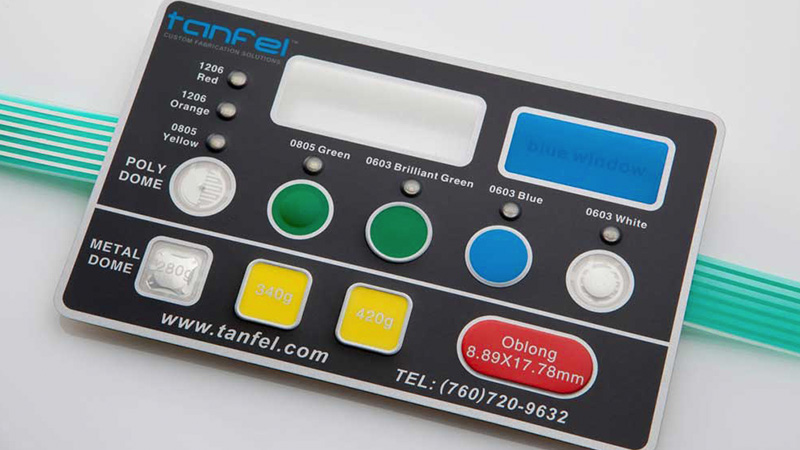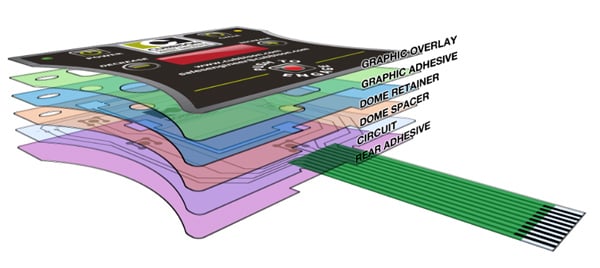Membrane Switches vs. Traditional Switches: What You Need to Understand
Membrane Switches vs. Traditional Switches: What You Need to Understand
Blog Article
Why Membrane Switches Are Crucial for Sturdy Control Solution
Membrane buttons play a critical duty in making certain the longevity and integrity of control systems across various sectors. As we explore the multifaceted advantages of membrane buttons, it ends up being noticeable that their relevance transcends simple performance, affecting customer experience and functional effectiveness.
Summary of Membrane Switches
Membrane layer switches are flexible and reputable elements generally used in various electronic control systems. These switches are composed of numerous layers, including a visuals overlay, a spacer layer, and a printed circuit layer. The visuals overlay offers both functional and aesthetic style, while the spacer layer makes sure that the switches are activated just when pushed. The printed circuit layer consists of conductive traces that complete an electrical circuit when the membrane layer is pushed, allowing the gadget to respond to customer inputs.
Membrane layer switches are typically favored in applications calling for a small and light-weight design, making them excellent for handheld devices, medical tools, and industrial equipment. They can be customized to meet certain individual needs and can incorporate numerous attributes such as backlighting, tactile responses, and multiple shades. In addition, membrane layer switches are resistant to dirt, dampness, and pollutants, making them suitable for settings where durability is essential.
Benefits of Longevity
In many applications, the sturdiness of membrane switches offers substantial advantages that boost their overall performance and reliability. These switches are designed to stand up to severe environments, making them ideal for usage sought after problems such as high moisture, extreme temperature levels, and exposure to chemicals. Their durable building and construction aids to stop damage from physical influence, making sure long-lasting performance and minimizing the requirement for regular substitutes.
Additionally, membrane switches are immune to deterioration, which is crucial in applications where constant interaction happens. This durability translates to decrease maintenance prices, as companies take advantage of minimized downtime and fewer solution disruptions. The encapsulated style of membrane switches over secures internal elements from dirt and dampness access, further adding to their life expectancy (membrane switch).
One more benefit is their ability to maintain consistent performance in time. With a high tolerance for mechanical anxiety, these switches preserve their responsive responses and electric stability, ensuring customer contentment. Eventually, the durability of membrane layer switches over not just boosts operational efficiency but also cultivates self-confidence in their dependability, making them a recommended selection for control systems across various sectors.
Applications in Numerous Industries
Resilient control systems employing membrane buttons locate substantial applications throughout an array of markets, each profiting from the special attributes these switches use. In the medical sector, membrane layer buttons are important for devices such as individual screens and analysis devices, where reliability and convenience of cleansing are vital. Their resistance to moisture and contaminants guarantees they maintain capability in clean and sterile settings.
The automobile market leverages membrane buttons for dashboard controls and infotainment systems, where they provide streamlined, low-profile user interfaces that improve customer experience. These switches are additionally created to withstand rough conditions, consisting of exposure to severe temperatures and resonances.
In industrial setups, membrane layer switches are typically used in equipment control panels, using responsive responses and toughness required for high-usage applications. Their capacity to resist chemicals makes them ideal for producing Resources settings where spills and contaminants are constant.

Customer electronic devices, such as kitchen home appliances and remotes, also utilize membrane switches for their adaptability and cost-effectiveness. Generally, the flexibility and robust nature of membrane layer Your Domain Name changes make them vital throughout various industries, making sure reliable procedure and long life in control systems.
Style and Visual Appeal
While functionality is paramount, the design and aesthetic appeal of control systems geared up with membrane switches play a vital role in individual interaction and general experience (membrane switch). The visual design of these switches can dramatically affect customer assumption and communication. A properly designed membrane layer button enhances the beauty of the gadget, making it much more appealing to customers and cultivating a link in between the customer and the item
Membrane changes provide a large amount of versatility in style, allowing manufacturers to customize graphics, shades, and structures to line up with brand name identity and product looks. The usage of dynamic colors and unique patterns can draw focus, while tactile feedback can strengthen the individual's interaction with the device. Additionally, the capacity to incorporate LED indicators and backlighting into the membrane layer button style provides both useful and visual benefits, boosting visibility and use in numerous settings.

Enhancing Customer Experience

Additionally, membrane layer buttons can be tailored to incorporate graphical interfaces, improving usability by presenting information in a clear and intuitive fashion (membrane switch). This customization can consist of icons, tags, and shade coding that overview individuals with complicated performances with ease. Furthermore, their convenience enables integration in various environments, guaranteeing regular performance whether in industrial equipment or customer electronic devices
The longevity of membrane layer buttons also plays a crucial role in user experience. By withstanding harsh conditions and expanded usage, these buttons decrease the possibility of system failures, hence advertising integrity and customer self-confidence. Inevitably, the critical use membrane switches not only elevates capability however likewise considerably improves user interaction with control systems, making them an important component in modern-day layout.
Verdict

Report this page